Xato and the Joe Wolter clinic
Part Two: Leading, Leaving and Loops
So now I’ve told you all about our (mostly self-inflicted) lorry troubles, I guess I’d better crack on with writing about the clinic itself – which was totally worth any stress we had getting there and back! I’m so glad I committed and took Xato, because it was a real privilege to ride with someone like Joe and the clinic opened up a whole new kaleidoscope of ideas for me.
Before I go any further, I want to point out that this will not be a technical, in-depth review written by someone who has a clue; you’ll have to look elsewhere for that (perhaps our interview with Joe in the August issue of Horsemanship Magazine? Just, er, just dropping that in there … carry on…). As always, Mulography is just a place where I record my (mis)adventures and my thoughts on why things did or didn’t work. It isn’t meant as a training manual.
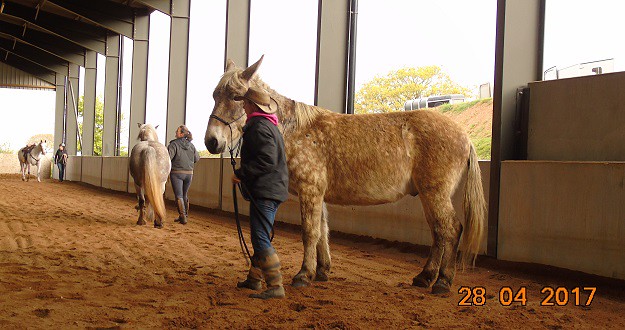
The clinic was split up into two sessions: the morning group, Horsemanship 1, was my class and was for the more inexperienced equines/riders; the afternoon group, Horsemanship 2, was for the more experienced partnerships like Ben and Iris.
Horsemanship 1 kicked off at 8:30am so I was really glad we were sleeping on site (the clinic happened before I started getting up at 5am to go riding with my friends, of course. I was not yet accustomed to the ways of the early and functioning riser). However, the early start was good for me as it meant I wasn’t spending the whole morning worrying. Instead, I condensed my worry into 60 minutes of vague, glassy-eyed panic that culminated in me desperately trying to convince Ben to take Xato from me once we’d entered the arena. The arena was secure and, as previously mentioned, very spacious; but the audience were seated behind nothing more than poles on the ground, and my brain was already full of worst-case scenerios. What if Xato got loose from me and ran into the crowd? What if he stirred up the other horses and they got loose as well? What if everyone was really angry with me for ruining their experience? What if there was an unexpected fae uprising and I suddenly regretted not having my mule shod with iron shoes?!
Oki, so the last one isn’t actually a concern of mine … usually. But you get the idea.
Ben refused to take Xato, and I guess Joe noticed and realised I was in need of help because he came over to lend a hand. He didn’t make me feel silly about it, either; that’s one of the things that really made this clinic amazing for me. Joe never belittled anyone, or made them feel foolish for not knowing something. To coin a Joe phrase: everything was a teachable moment! That was particularly important for someone like me who doesn’t have a lot of self-confidence and was already feeling pretty bad about how wrong things had gone lately.
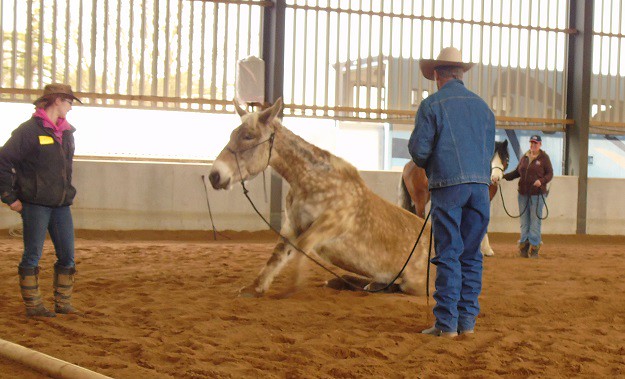
Joe took Xato to get a feel of where he was at, and the funny thing was that Xato decided to have a roll – twice! Joe was happy to let him and it was really interesting for me to see. Xato’s energy had been quite up when he entered, and I was surprised that he felt he could put himself in such a vulnerable position; then again, it seems to me that mules treat rolling a little differently than horses do. I have seen both Marty and Xato use rolling as a kind of territorial thing, an act that says “this is mine”, and I wonder if that’s what Xato was doing. As I was to discover later in the clinic, Joe exudes an aura of calm that attracts the equines too – so I suspect another part of it was that Xato just felt good with him.
Joe pointed out that I was trying to hold onto Xato, rather than simply going together; this was interesting to me, because it reminded me of how much of a spectrum horsemanship can be. For example, as a groom working on traditional yards, I will often see people leading a horse with their hand right under their horse’s chins; a death-grip that suggests they have a) not yet been launched into the air by a horse who is determined to leave and b) don’t realise that this way of crowding the horse actually makes them more anxious and more likely to be strong or difficult to lead. Now, I considered myself to be holding Xato fairly loosely in comparison – I always aim to have that “smile” in the rope (to be fair to the traditional folk, this is easier to do with a decent rope; those five foot leadropes tack shops sell are utterly pointless). But I was still missing the point. There is always an improvement to be made, whether it’s huge and obvious or so minuscule it’s barely noticeable. Sometimes the things that team minuscule to us are a huge deal to our equines.
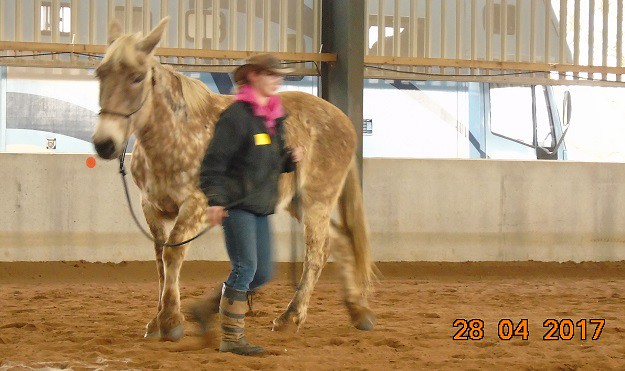
So Joe set off and just expected Xato to come with him. He didn’t worry about him trailing behind – whereas I had been trying to hustle him and make him walk at my shoulder – but left a nice, long rope between them. Joe changed direction often, which kept Xato from getting heavy; he was engaged, always wondering what was coming next, and therefore didn’t fall into that habit of letting himself be dragged along. It also prevented his mind from wandering out of the arena.
At one point while out on a circle, Xato left and Joe let him go; he said there was no point trying to hold onto him because it would just set up a fight, and make the mule more worried. This was actually quite reassuring because this was the approach we had been taking ourselves, albeit with less finesse! “The mule needs to make his own decisions,” said Joe, “and we need to influence him to want to stay with us.” It was about asking him to choose to be with us, not trying to control him. “Don’t give them anything to pull against.”
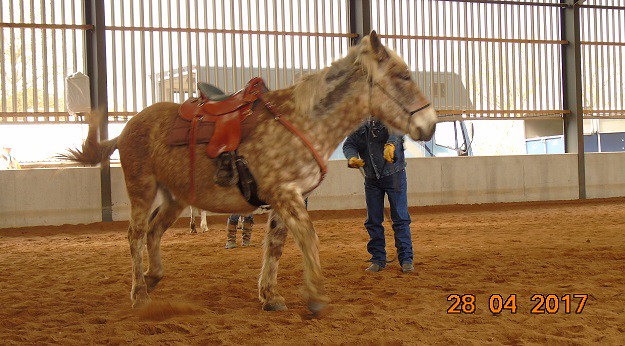
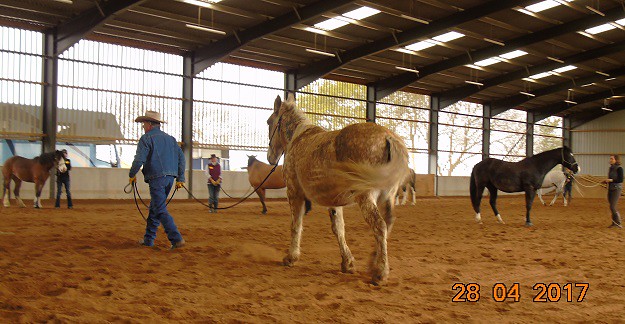
Leaving while out on a circle – particularly when asked to go into trot – is something Xato has struggled with. Joe’s suggestion is to ask for that upward transition while the equine is heading towards the fence, rather than facing out into the open expanse of the arena or field. If you don’t get the transition, quit and ask for it again when you next come around. This was really useful for me with Xato because what had been happening was this: I ask for more energy, Xato gets worried, Xato leaves, Xato remembers the worry, Xato retains the worry, the problem perpetuates itself. His tendency to leave as soon as something bothers him makes it difficult to work through that concern. But doing it Joe’s way, I was able to build his confidence – and mine. I was able to say, “Hey, how does this feel?” and then bring him back down while he was still comfortable.
Another issue we fixed regarding circle work was that I was unwittingly blocking Xato’s attempts to actually move forward. With Marty, I ask him to move up and down transitions with my body language; I’ll put more life into my feet and step bigger to ask him to speed up, and drop slow and quiet to slow down. This has worked fine with Marty but, as we all know, what works for one doesn’t necessarily work for another! By bringing my energy up and forward, I was effectively creating a barrier which Xato felt he could not pass. By asking him to go and stop at the same time, of course he would choose to get out of there. I was amazed at the difference it made by keeping behind his driveline.
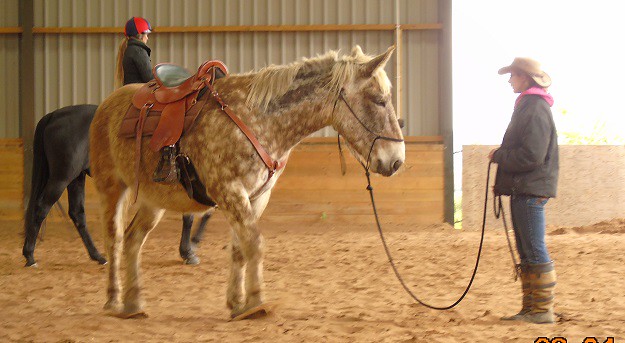

I guess as a mule that has been driven…albeit with his mum, maybe he is more sensitive to you being behind the driveline… just a thought. xx
He’s been long-reined and he’s worn harness, but he’s never been driven.